BUDA + PEST = BUDAPEST! - AND BITS OF VIENNA
This time its Budapest.
Budapest:is the capital city of Hungary and the country's principal political, cultural, commercial, industrial and transportation center.
Budapest has approximately 1.7 million inhabitants, down from a mid-1980s peak of 2.1 million. Budapest became a single city occupying both banks of the river Danube with the amalgamation on 17 November 1873 of right-bank Buda (Ofen in German) and Óbuda (Old Buda or Alt-Ofen) together with Pest on the left (east) bank. It is the seventh largest city in the European Union.
Buda is The Hilly Part and Pest is the Flat Part.well to make a short story long or long story short however you wanna look at it, I went to Budapest on Monday morning and came back Friday morning. Well to my luck Monday Was a National Holiday and the whole city was close, so nothing much happneed Monday.
Monday:
Shmuly Friedman giving a Gemrah Shiur



Velly on the Computer


Tuesday:


Winter Shul that the Dohany memebers use during the winter.


The Dohány Street Synagogue or Great Synagogue (Dohány utcai Zsinagóga/Nagy Zsinagóga) in Budapest is the largest synagogue in Europe and the second largest in the world, after the Temple Emanu-El in New York City. It has seating for 3000 people and is a centre of Neolog Judaism.
The synagogue has a length of 75m and a width of 27m and was built between 1854 and 1859 in Moorish-style, based chiefly on Moslem models from North Africa and Spain (the Alhambra), according to a plan by Ludwig Förster, with interior design partly by Frigyes Feszl.
Franz Liszt and Camille Saint-Saëns played the organ there.
The original synagogue was bombed by the pro-Nazi Arrow Cross Party on 3 February, 1939 and was used as a base for German Radio and as a stable during World War II.
A three-year program of reconstruction (funded largely by a donation of US$5 million from Estée Lauder) was completed in 1996.
The square in front of the synagogue is named after Theodor Herzl, who was born in a house near the location in 1860. The Jewish Religious and Historical Collection adjoins the synagogue.
The Raoul Wallenberg Emlékpark (memory park) in the rear courtyard holds the Memorial of the Hungarian Jewish Martyrs (600,000 Hungarian Jews were murdered by the Nazis) together with a memorial to Wallenberg and other Righteous Among the Nations, such as Swiss Vice-consul Carl Lutz, who saved tens of thousands of Hungarian Jews during World War II.

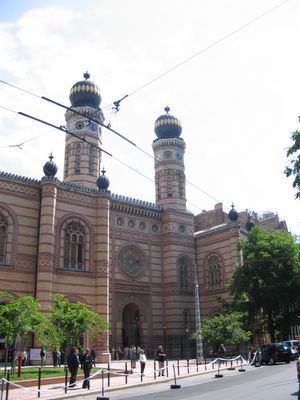










Directions if you get lost


Cemetery by the ghetto


Weeping Willow Tree
A memorial, a weeping willow tree made of granite and steel commemorates all the Hungarian victims of the Holocaust




Part of the Ghetto Wall




Pizza Shop

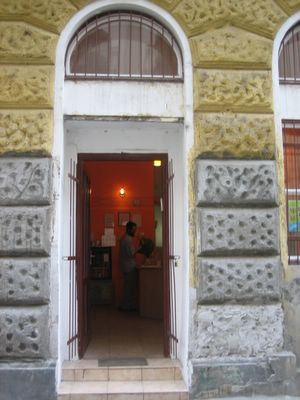




Vaci Utca
Budapest's most popular pedestrian street
While the first section is lively and popular, the new area has more charm and authenticity. Together, they are both truly European: dozens of cafés, fancy shops and boutiques and some truly stunning architecture. Don't forget to look up as you stroll down Vaci utca - some of the façades are truly amazing.








Chaim this is for you




The „Cigar Tower” is located in the inner city next to the most famous and most expensive Hungarian Hotel, the Kempinsky.


Erzsébet híd, Erzsébet Bridge or Elisabeth Bridge is the second newest bridge and one of the most elegant ones of Budapest, Hungary, connecting Buda and Pest across the River Danube. It is situated at the narrowest part of the Danube, the bridge spanning only 290 m. It is named after Queen Elisabeth, a popular queen and empress of Austria-Hungary, who was tragically assassinated. Today, her large bronze statue sits by the bridge's Buda side connection in the middle of a small garden.
Its two ends are
- Március 15. tér (with the oldest church in Pest, Inner City Parish Church, built in the XIII century) and the famous Mátyás Pince restaurant
- Döbrentei tér in Buda with the monument of Saint Gellert on the Gellért Hill, a sculpture of Queen Elisabeth and the Rác Baths and Rudas Baths nearby. A luxury spa hotel is currently being built in the area.
The original permanent crossing, a decorative chain bridge, was built between 1897 and 1903, amid a corruption scandal. The Buda end of Erzsébet bridge runs directly into the massive foot of Gellért Hill, necessitating a complicated arrangement of roads to connect to the bridge. The bridge was designed in such a way because a wealthy nobleman, who sat on the City Council at the time owned the particular area of the riverbank. He wanted to make a fortune by selling the piece of land for bridge constructon purposes, bribing the other councilmen and engineers on purpose. He managed to sell the land at greatly inflated prices. In the era of horse drawn carts the geometry issue was not considered significant and the resulting cost overruns were covered up, therefore no prosecution took place. In recent decades, many motorists have been permanently injured or killed in the sharp turn that immediately follows the bridgehead. After a terrible accident in 2004, which killed a family, a speed limit of 40 km/h was posted for the west-bound lanes.
The original Erzsébet híd was blown up at the end of World War II by retreating Wehrmacht sappers. This is the only bridge in Budapest which could not be rebuilt in its original form. Pictures and some salvaged elements from the old bridge can be seen on the grass in front of the Museum of Transport in City Park.
The currently standing slender white cable bridge was built in the very same location between 1961–1964, because the government could not afford to construct entirely new foundations for the bridge. The main spar cables of the bridge are hexagonal in cross section, composed of thousands of elementary steel wires of seven different diameter, partly because early computers were unable to provide solution for a circular cross section main cable batch.
The novel design, planned by Pál Sávoly, was a first in Central Europe and not without weaknesses. Tram traffic and its heavy tracks had to be removed from the bidge in 1973 after signs of cracks appreared in the structure. The 2×3 lane Erzsébet bridge is relatively well maintained because it is part of the route where foreign dignitaries are being taken from Ferihegy Airport to the government quarter.






Széchenyi lánchíd or Széchenyi Chain Bridge is a suspension bridge that spans River Danube between Buda and Pest, the west and east side of Budapest, the capital of Hungary. The first bridge across the Danube in Budapest, it was designed by the English engineer William Tierney Clark in 1839, after Count István Széchenyi's initiative in the same year, with construction supervised locally by Scottish engineer Adam Clark (no relation). It opened in 1849, thus became the first bridge in the Hungarian capital. At the time, its center span of 202 m was one of the largest in the world. The pairs of lions at each of the abutments were added in 1852.
Its two ends are
- Roosevelt square (with the Gresham Palace and the Hungarian Academy of Sciences) and
- Adam Clark square (the Zero Kilometre Stone, and the lower end of the Budapest Funicular, leading to Buda Castle).


The Royal Castle



















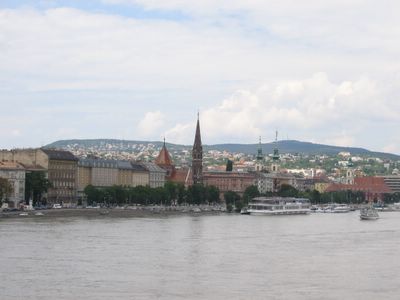




Wednesday:






Heroes' Square (Hősök tere in Hungarian) is one of the major squares of Budapest, Hungary. It lies at the end of Andrássy Avenue (with which it comprises part of the World Heritage), next to City Park.
It is surrounded by two important buildings, Museum of Fine Arts on the left and Palace of Art (or Art Exhibition Museum) on the right. On the other side it faces Andrassy Avenue which has two buildings looking at the square — one is residential and the other one is the embassy of Serbia and Montenegro (former Yugoslavian embassy where Imre Nagy secured sanctuary in 1956).
The central sight of the square, as well as a landmark of Budapest, is the Millennium Memorial (also known as Millennium Monument or Millenary Monument) with statues of the leaders of the seven tribes that founded Hungary in the 9th century and other outstanding figures of Hungarian history (see below). The construction of the memorial was started when the one thousandth anniversary was celebrated (in 1896), but it was finished only in 1929 and the square got its name then.
On the 16th June 1989 a crowd of 250,000 gathered at the square for the historic reburial of Imre Nagy, who had been executed in June 1958.
It is also a station of the yellow M1 (Millennium Underground) line of the Budapest Metro.







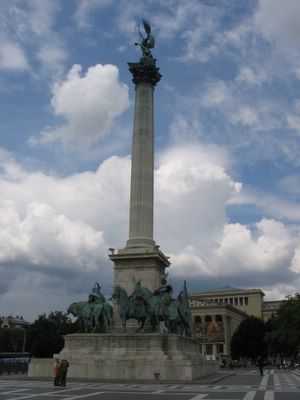


Internet Cafe - No Cell Phones this time


Rudas Baths
(Spa Center)
Rudas Baths, a thermal bath was built in the 16th century, by Pasha of Buda Sokoli Mustapha, since when it has been operated virtually unchanged to this day.The baths are fed by 3 famous springs: Juventus, Attila and Hungaria and 15 smallersprings.The lightly radioactive,calcium-magnesium-hydrogen-carbonate waters contain sulphates and fluoride. The water of the Juventus spring that can be utiliyed as bath form has rejuvenating effects, hence the name.







Gellért Hill or Gellérthegy is part of Budapest’s XIth District, and is mainly centred around the eponymous Gellért-hegy (Gellért Hill), named after the saint thrown to his death from the hill. The famous Hotel Gellért and the Gellért Baths can be found in Gellért Square at the foot of the hill, next to Liberty Bridge.
The highest point of the hill is 235 m. At the top of the hill is the famous Citadella (Citadel), from which a glorious view is available down both directions of the Danube. The Citadel was built by the ruling Habsburg Austrians and used to shell the unruly Hungarians in their ultimately unsuccessful 1848 uprising, as it was a prime, strategic site. It also saw action in the Second World War and the 1956 Hungarian Revolution, when Soviet tanks stood up on the hill and fired down into the city. Indeed, battle scars still pockmark the building. There is a small military museum in the Citadel’s grounds.
Now an affluent residential area, a number of embassies and ambassadorial residences line the windy streets up the hill. Since 1987, the area is listed as a world heritage site.












Farbrengen For one of the Students going to Israel.






Israeli Chabad House of Budapest




Kings Restaurant








Kosher Grocery


Milk & Honey





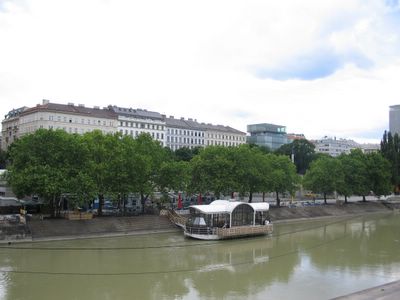





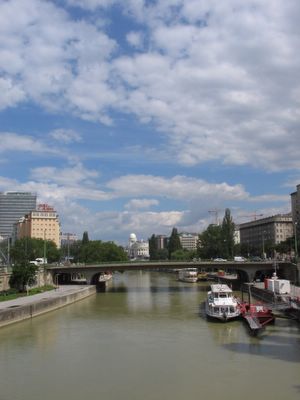






Kosher Bakery



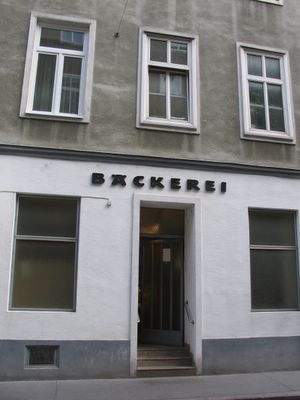







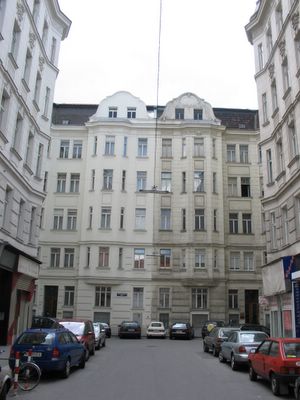
Lauf And Kauf - Run and Buy Sounds cool!!!


Everywhere you go there is construction






Nature Along The Train Ride














Sunset on the way From Vienna To Budapest










Moon Coming out During the Sunset




Budapest Keleti Train Station


Sunset over the train station.

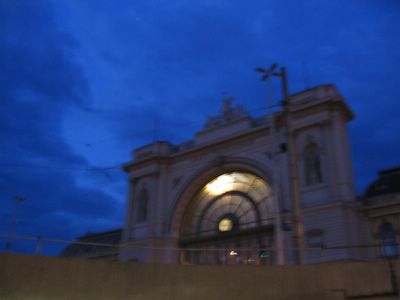
Metro






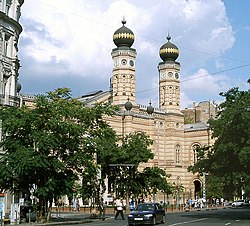




1 Comments:
waaay too many pics! it takes a really long time just for them to load, i see you're having a great time in europe!
Post a Comment
<< Home